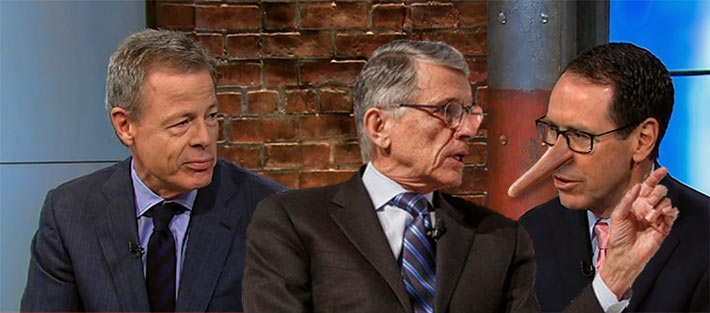
Randall Stephenson (right), Chairman & CEO, AT&T, will most likely inform FCC Chairman Tom Wheeler (center) that the deal will not affect the carrier’s capex spending on its wireless network. However, he gave the same assurances to the industry in 2014 when AT&T acquired DirecTV, and a few short weeks later crippled many companies when AT&T’s build-out came to a sudden stop. Time Warner CEO Jeff Bewkes (left) and Stephenson will find the acquisition to be a hard sell to some regulators.
In discussing AT&T’s deal to acquire Time Warner for $85 billion, AT&T CEO Randall Stephenson said in a conference call yesterday morning, “We’re convinced this combination of Time Warner and AT&T is a perfect match for both companies.”
In a canned statement, Stephenson said, “We intend to give customers unmatched choice, quality, value and experiences that will define the future of media and communications.”
Recalling 2014’s acquisition of DirectTV by AT&T when the carrier put all build projects on hold – and in the process caused numerous companies to lose millions of dollars as they were forced to downsize – a number of industry executives are hoping that AT&T’s latest move to again diversify its revenue mix will not stall its wireless capex projects and there will be a more defined future for vendors and contractors.
Stephenson said that the deal would improve his company’s bottom line. However, it will also require adding network densification in order to fuse Time Warner’s content with AT&T’s delivery, a good thing for the wireless infrastructure industry, especially for small cell providers.
But it is unlikely that the deal would close any earlier than the end of 2017, or possibly longer since the acquisition will draw regulatory scrutiny, slightly oiled by the two companies’ statements that they don’t compete in the same business areas.
In order for the Department of Justice to block the deal, the DOJ would need to prove that the acquisition hurt competition. The FCC has broader powers, however, and can deny the deal it found was not in the “public interest” if it involves the sale of a broadcast license.
Bank of America has pledged to get a $40 billion bridge loan that would be later paid off through the issuance of bonds. Nonetheless, there will be net debt covenants that could alter capex spending.
Is it necessary to pair content with the delivery system
John Celentano, an independent telecom marketing consultant and wireless infrastructure expert, has recycled the long-running argument: Does a service provider like AT&T need to own both the content and the underlying distribution infrastructure?
There are arguments both ways, says Celentano who believes that a vertically-integrated AT&T can deliver unified communications (UC) that potentially will drive new revenues as its legacy wireline and wireless businesses are floundering.
“UC includes wireless, high-speed Internet access, voice telephony, streaming video, programming and movies. This is robust content that AT&T would own or control, and would deliver it over its own wireless, wireline and cable networks. Selling bundled services like this allows the company to create original content available across multimedia as a competitive differentiator, and will help the company weather vagaries in the economy and the marketplace,” explained Celentano.
But the real question is, according to Celentano, can AT&T afford to do both since building and operating state-of-the-art infrastructure needed for reliable UC delivery to over a combined 150 million subscribers requires massive and sustained capital expenditures.
“Demand for mobile data and video service is escalating with no end in sight. Yet AT&T reduced its 2016 estimated wireless capex to $8.4 billion from a peak of $11.4 billion in 2014, arguing that its 4G LTE build-out is essentially complete and that network capacity can be added through software upgrades.
“In fact, AT&T’s wireless subscriber growth has plateaued and competitors are poaching customers. More important, its postpaid wireless average revenue per user is flat to down and DirecTV returns have yet to kick in. Yet with mobile data volumes projected to grow at 6-8 times by 2020, AT&T and its peers must continue expanding their networks or fall farther behind. This means placing tens of thousands of wireless access points like small cells closer to customers,” said Celentano.
The Time Warner acquisition will only exacerbate AT&T’s need for necessary network investments to deliver UC, Celentano said.
AT&T’s Cirque du Soleil capex surprises
Even though the company has couched its capex intentions and reporting in recent months, it behooves AT&T to provide clear guidance on its capex plans, said Celentano, who emphasized that hundreds of equipment vendors and thousands of workers that support the company depend on that steady infrastructure expenditure.
“If AT&T is unwilling or unable to invest in its networks as it shifts focus on services and content, then it should consider getting out of the infrastructure business altogether,” said Celentano.
If AT&T’s deal doesn’t gain regulatory approval, it must pay a $500 million reverse break-up fee to Time Warner, according to a Bloomberg report.


















